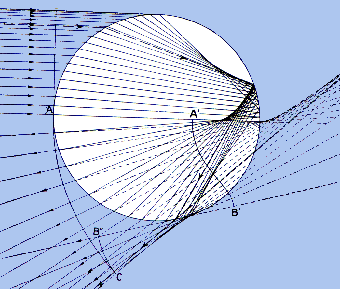| Back of the CED Envelope |

|
| Back of the CED Envelope |

|
The illustration above is drafted-anew version of the internal reflections of sunlight in a cloud drop was originally published by W. J. Humphreys (1920) The Physics of the Atmosphere. This wonderful book is still in print by the scientist's good friends at Dover Publications Inc. It is a great buy and a must for your bookshelf.
What light through yonder cloud droplet breaks? In the illustration above rays of light approach the northwest quarter of a raindrop and penetrate. The light ray is bent toward the center of the drop and hits and reflects off the "back wall" of the drop. It then caroms toward the "front wall" of the drop in the southwest quarter, emerges and heads back in the general direction from which the light came. Since the angles of reflection depend on the wavelength of the light, the light that emerges is "prisimized" for display as a rainbow. Now some of the light does not make it back out but caroms around inside the drop a second time and if it emerges is displayed as the second band in a double rainbow. Some of the light also penetrates through the "back wall" of the drop and goes away from the drop and the illumination source. So we have both forward and backward scattering. This scattering was reported in CED regarding the mist from a manure pile [ see CED 2.3, Vol. 2 No. 3, April 1, 1993]. Some of the light that enters the cloud drop doesn't make it back out. It is absorbed. It heats the drop a bit. Old theory tells us that about 6% of the light entering the drop is absorbed. Old measurements and new measurements tell us it closer to 20%.
Back in March of 1994, the Vol. 4 No. 3 issue of CED reported the news that cloud drops absorb about 20% of the light that passes through their meniscus rather than the theoretical 6%. "So what does it mean to have our clouds do a 20% job on sunlight rather than a 6% job? First of all it reduces the sunlight to reach the ground by some 25 Watts per square meter. If that doesn't ring a bell, consider that the theoretical, extra downwelling of IR resulting from 2XCO2 is only 2 Watts per square meter! So the atmosphere with its clouds gets warmer (it absorbs more sunlight) and the surface gets cooler (it gets less sunlight). Perhaps the GCM warming due to almost a century of rising CO2 doesn't match reality because the models telling us about reality didn't have the right theory in them. Modelers who have rushed to their models to have their clouds do a 20% rather than the old 6% job report "pleasing improvements in simulated climate." In the climate beauty contest of model outputs they mean it looked better.
The paper that has grown from the modelers rush to their GCM models to see what it all meant is now in print in the Journal of Climate 8:2200-2212. Kiehl, Hack, Zhang and Cess did the work and tell us how they tuned the NCAR CCM2 GCM to have the model clouds absorb the extra sunlight. Kiehl and the boys found that the surface of the earth got 22 W / m^2 less sunlight for heating and the atmosphere through the hard work of the cloud drops gained that 22 W / m^2 of energy. CED in the Spring of 1994 back of the enveloped this calculations and came up with 25 W / m^2. Not bad at all.
The new paper codifies this "pleasure." "We note that a number of these changes due to enhanced absorption [like the real world, sic CED] help address known biases in the standard CCM2 climate simulations. CCM2 over predicts surface latent heat flux and precipitation, and in the Tropics the surface winds are too strong. All of these biases are addressed to a large degree when enhanced shortwave cloud absorption is included." Better models through better physics. This paper is testimony to sound scientific advice that we test models with data not the other way around.
Hayden, B. P. 1993. Mature Manure Mists. CED. Vol. 2 No. 3.
Hayden, B. P. 1994. Brighter Future from Darker Clouds. CED. Vol. 4 No. 3.
Humphreys, W. J. 1920. Physics of the Air. The Franklin Institute. Philadelphia. (Also Dover Publications, 1964).
Kiehl, J. T., J .J. Hack, M. H. Zhang, and R. E. Cess. 1995. Sensitivity of a GCM Climate to Enhanced Shortwave Cloud Absorption. J. of Climate 8:2200-2212.